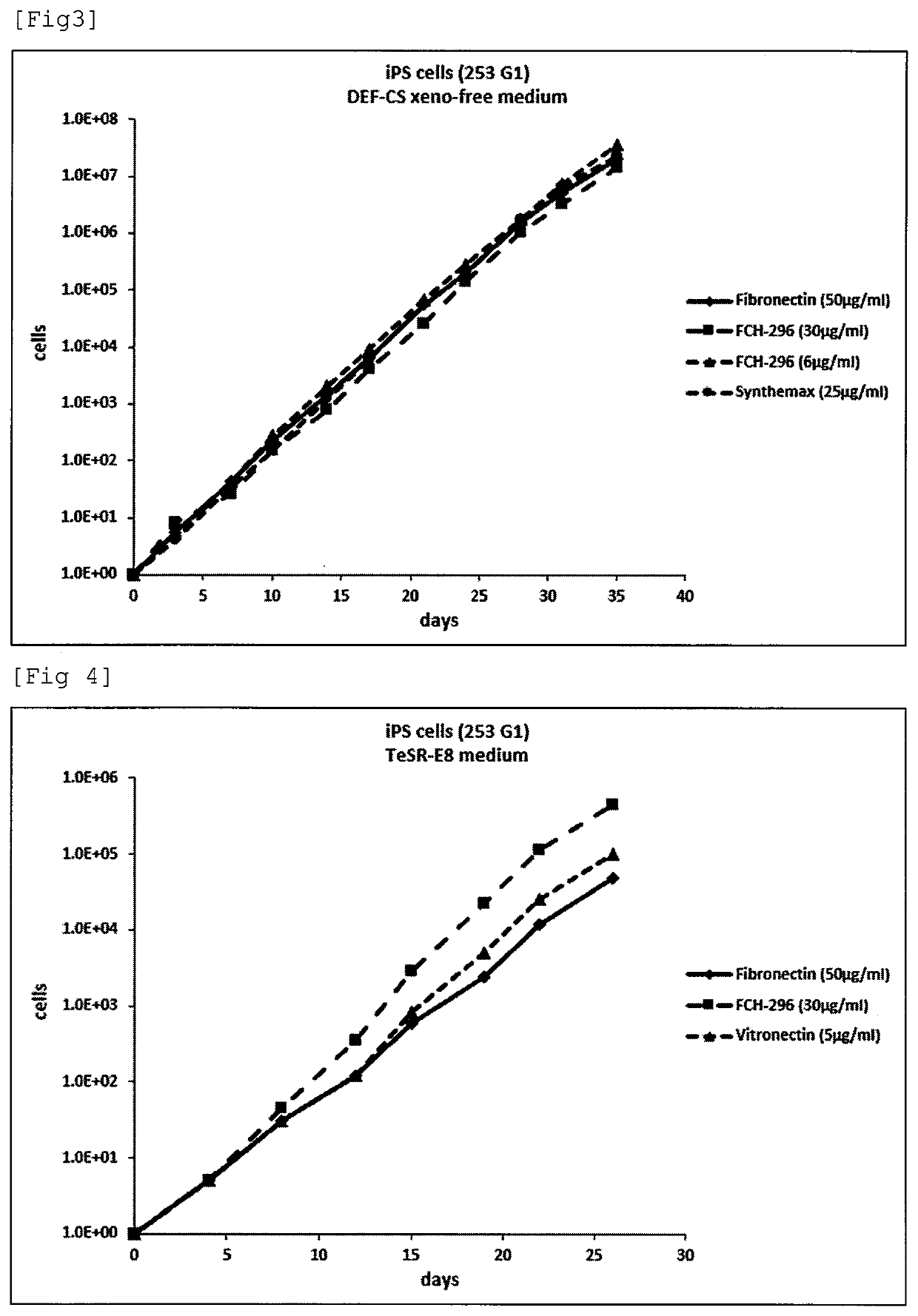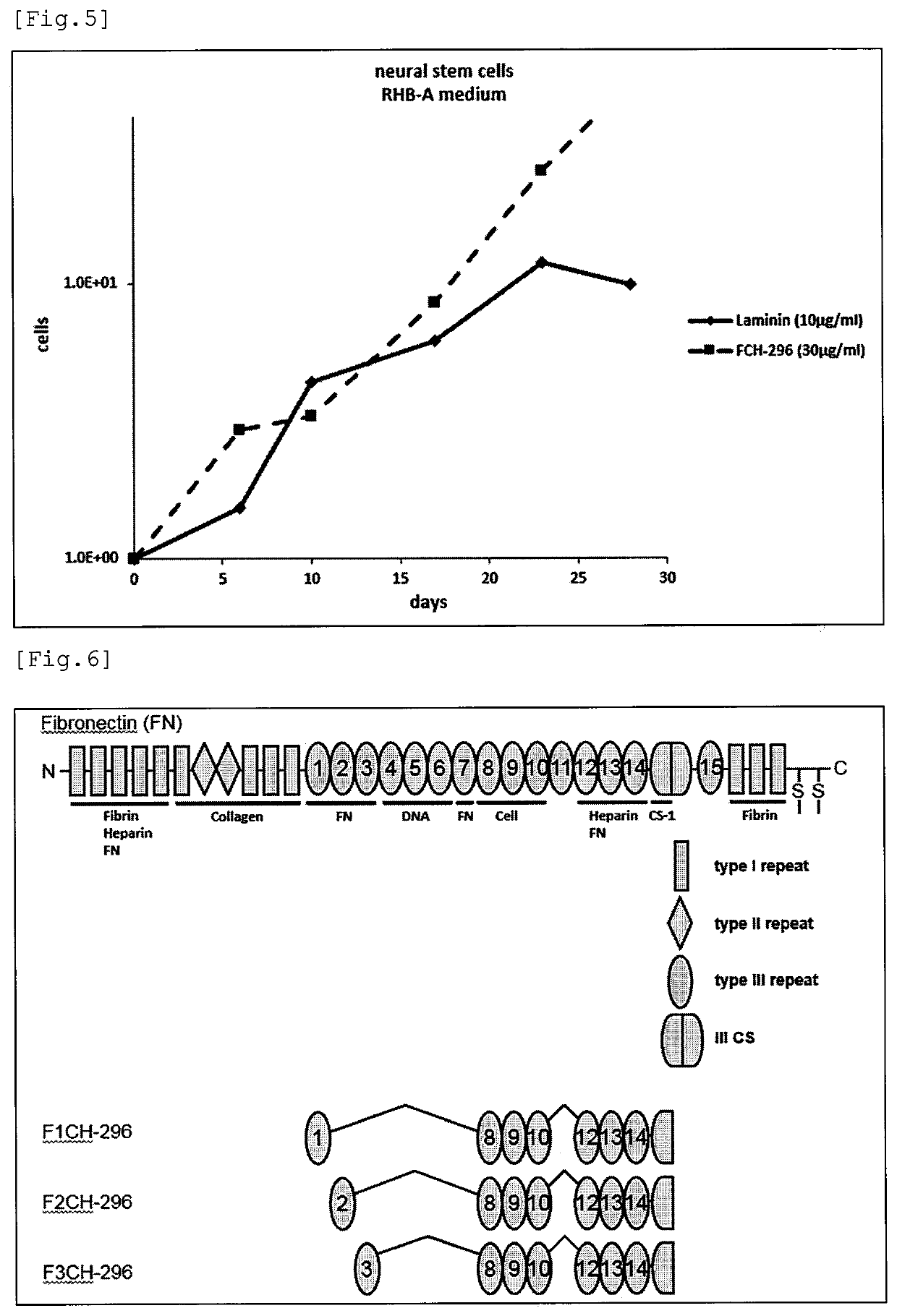Fibronectin fragment to be used for stem cell production
a technology of stem cells and fibronectin, which is applied in the direction of peptides, peptides/protein ingredients, genetically modified cells, etc., can solve the problems of insufficient stem cell production technique, high risk of viruses and the like brought by origin organisms, and insufficient technique for producing sufficient stem cells, etc., to achieve high cell proliferation rate, and efficient stem cell proliferation
- Summary
- Abstract
- Description
- Claims
- Application Information
AI Technical Summary
Benefits of technology
Problems solved by technology
Method used
Image
Examples
example 1 preparation
of FCH-296
[0095]An FCH-296 polypeptide having a His-tag composed of a methionine residue and 6 histidine residues at the N-terminus (SEQ ID NO: 21) was prepared by the following procedure.
[0096]DNA encoding the polypeptide was artificially synthesized and incorporated into an expression plasmid. Escherichia coli was transformed with the plasmid, and the resulting transformant was cultured under the conditions that allowed the expression of the polypeptide. The microbial cells collected from the culture were disrupted with an ultrasonic crusher (manufactured by KUBOTA Corporation) to obtain a cell-free extract. Using the extract as a starting material, FCH-296 was purified by a series of column chromatography of Ni-Chelating Sepharose (manufactured by GE Healthcare), Hydroxyapatite (40 μm, manufactured by Bio-Rad Laboratories, Inc.) and SP-Sepharose (manufactured by GE Healthcare). Confirmation of FCH-296 in the purification process was carried out by SDS-PAGE / CBB staining. The buffe...
example 2
Preparation of DCH-296
[0098]A DCH-296 polypeptide having a His-tag composed of a methionine residue and 6 histidine residues at the N-terminus (SEQ ID NO: 22) was prepared by the following procedure.
[0099]DNA encoding the polypeptide was artificially synthesized and incorporated into an expression plasmid. Escherichia coli was transformed with the plasmid, and the resulting transformant was cultured under the conditions that allowed the expression of the polypeptide. The microbial cells collected from the culture were disrupted with an ultrasonic crusher to obtain a cell-free extract. Using the extract as a starting material, DCH-296 was purified by a series of column chromatography of Ni-Chelating Sepharose, Hydroxyapatite, and SP-Sepharose. Confirmation of DCH-296 in the purification process was carried out by SDS-PAGE / CBB staining. The buffer of the obtained sample was replaced with a buffer [0.2 g / L KCl, 0.2 g / L KH2PO4, 8 g / L NaCl, 1.15 g / L Na2HPO4] to obtain 3 mL of a DCH-296 s...
example 3
Evaluation of Adhesiveness of Various Fibronectin Fragments to Human iPS Cells
[0101]Each of full-length fibronectin (derived from human plasma; manufactured by Sigma-Aldrich Co. LLC., F0895, final concentration: 50 μg / ml), 120 k-fr (manufactured by Millipore Corporation, F1904, final concentration: 40 μg / ml), CH-271 (J. Biochem., Vol. 110, p. 284-291 (1991), final concentration: 25 μg / ml), and CH-296 (RetroNectin: manufactured by Takara Bio Inc., final concentration: 20 μg / ml) was dissolved in D-PBS (manufactured by PromoCell GmbH, C-40232) to prepare a coating solution. After the coating solution was added to a 12 well Tissue culture treated plate (manufactured by Corning Incorporated, 3513) at 0.4 mL / well, the plate was capped and was left to stand overnight at 4° C. On the next day, the coating solution was removed from the plate, and then the plate was washed twice with 1 mL / well of D-PBS to obtain a plate coated with each polypeptide. For coating with two kinds of fibronectin f...
PUM
| Property | Measurement | Unit |
|---|---|---|
| molecular weight | aaaaa | aaaaa |
| molecular weight | aaaaa | aaaaa |
| molecular weight | aaaaa | aaaaa |
Abstract
Description
Claims
Application Information
 Login to View More
Login to View More - R&D
- Intellectual Property
- Life Sciences
- Materials
- Tech Scout
- Unparalleled Data Quality
- Higher Quality Content
- 60% Fewer Hallucinations
Browse by: Latest US Patents, China's latest patents, Technical Efficacy Thesaurus, Application Domain, Technology Topic, Popular Technical Reports.
© 2025 PatSnap. All rights reserved.Legal|Privacy policy|Modern Slavery Act Transparency Statement|Sitemap|About US| Contact US: help@patsnap.com



